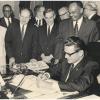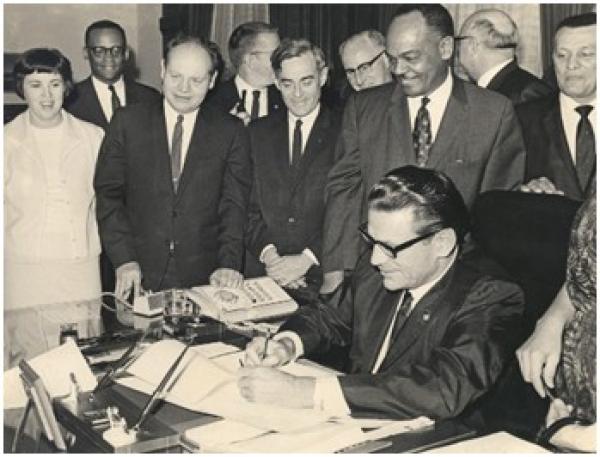Rules in Different Places
| Grade | Kindergarten | Class | Social Studies | Length of Lesson | 40 Minutes |
| Lesson Title | Rules in Different Places |
| Unit Title | Laws |
| Unit Compelling Question | How are laws different in other countries than in the U.S.? |
| Historical Context: The judicial branch is in charge of making laws for the United States. The founding fathers developed a system whereby each proposed law goes through a process before being approved or denied. Laws developed early in mankind's history and are constantly being revised and changed in response to current events. The first United States law passed was by George Washington. It was an act to regulate the Time and Manner of administering certain oaths. In the United States there are four different types of laws: criminal, civil, common, and statutory. Every year new laws are written and existing laws are changed based on current events. ~ Allyson Simpson, Simpson College 2018.012.007. This photograph shows Iowa Governor Harold Hughes signing the Fair Housing Bill into law in 1967. Before the Fair Housing Bill was passed, the Iowa Legislature passed a law to establish a Civil Rights Commission in 1965. Its purpose was to enforce the Iowa Civil Rights Act of 1965 and investigate complaints of discrimination based on race, national origin, and religion. The Fair Housing Bill was created in response to reports that African Americans had difficulties obtaining decent housing. The Fair Housing Act was passed by Lyndon B. Johnson and protected individuals from discrimination (based on race, gender, disability, religion or national origin) when purchasing or renting property. The Act was part of the Civil Rights Act of 1968 and is enforced by the US Department of Housing and Urban Development. |
|
| Lesson Supporting Question | |
| Lesson Overview | Students will be introduced to laws from around the world and discuss why these are good laws to have. Students will also look at laws from the U.S. from long ago and determine if those laws are good laws as well, while learning how to start thinking like a historian. We will discuss as a class how laws serve society. |
| Primary Sources Used |
|
| Resources Needed | |
| Standard | |
| Lesson Target | The Kindergarten students will be able to compare laws that the United States have and other countries have by answering a set of questions about laws. This will be measure by how students respond to the questions and answering. |
| Lesson Themes | |
|
| Formative Assessment (How will you use the formative assessments to monitor and inform instruction?) |
I am assessing the students by taking anecdotal notes of student’s responses to a set of questions that I will be asking after looking at the two pictures and the slideshows. |
| Summative Assessment (How does the lesson connect to planned summative assessment(s)?) |
This lesson is a build up to a summative assessment. At such a young age, I wanted to only focus on one large standard and break it down for them in a fun an exciting way. This lesson focus is on looking at laws around the world, not only the laws that the United States has. I wanted to start with the higher up laws that they are able to see with the primary document and then get easier with the slide show of different laws from around the world. Students are going to be able to relate more to the slideshow than the primary document during this. |
| Author | Kara Campfield | Created | Last Edited | ||||
| Reviewer: Dr. Chad Timm, Simpson College | |||||||
| Lesson Plan Development Notes: Social Studies Methods, Simpson College, Spring 2019 | |||||||


